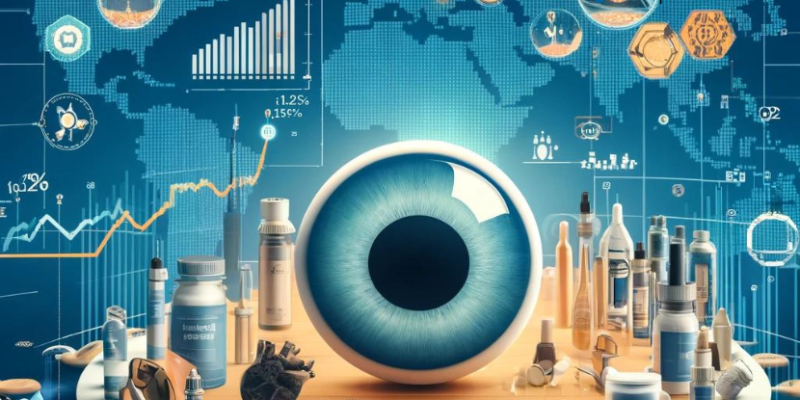
ry eye disease (DED) is a common condition affecting millions of people globally, leading to discomfort, visual issues, and a diminished quality of life. As awareness increases and diagnostic methods improve, the market for dry eye disease treatment is growing rapidly. Valued at approximately USD 5.91 billion in 2023, this market is projected to reach nearly USD 9.76 billion by 2032, with a compound annual growth rate (CAGR) of 5.7%.
What is Dry Eye Disease?
Dry eye disease occurs when the eyes fail to produce sufficient tears or when the tears evaporate too quickly, causing inflammation and damage to the eye’s surface. This condition can result from various factors, including aging, environmental conditions, medical conditions, and certain medications. Symptoms include dryness, irritation, a gritty sensation, and blurred vision, significantly impacting daily activities such as reading, driving, and using digital devices.
Key Drivers of Market Growth
- Increasing Prevalence of DED: The rise in dry eye disease cases, especially among the aging population, is a primary driver of market growth. Studies indicate that the prevalence of DED increases with age, making it a common condition among the elderly. Additionally, lifestyle factors such as prolonged screen time, contact lens use, and exposure to environmental pollutants contribute to the growing number of cases.
- Technological Advancements: Innovations in treatment options are fueling market expansion. New drug formulations, such as cyclosporine and lifitegrast, have shown efficacy in reducing inflammation and improving tear production. Advanced diagnostic tools, including tear osmolarity testing and imaging technologies, enable more accurate diagnosis and personalized treatment plans.
- Growing Awareness: Enhanced awareness about the symptoms and treatment of DED among both patients and healthcare providers is boosting demand. Public health campaigns and educational initiatives by healthcare organizations and pharmaceutical companies are playing a crucial role in increasing awareness and encouraging early diagnosis and treatment.
Major Players in the Market
Several key players dominate the global dry eye disease treatment market, continually expanding their product portfolios and improving treatment efficacy. Prominent companies include:
- AbbVie Inc.: Known for its robust pipeline and significant market share in the pharmaceutical sector. AbbVie has made significant investments in research and development to introduce new treatments for dry eye disease.
- Bausch and Lomb Incorporated: A leader in eye health products, offering a wide range of treatments for DED, including prescription medications, over-the-counter products, and surgical devices.
- Johnson & Johnson Services, Inc.: A major player with innovative products in the eye care market. Johnson & Johnson’s vision care division focuses on developing advanced contact lenses and eye drops for DED management.
- Santen Pharmaceutical Co., Ltd: Specializes in ophthalmic treatments and has a strong presence in the Asian market. Santen is known for its comprehensive range of products addressing various eye conditions, including dry eye disease.
- OASIS Medical: Offers a variety of therapeutic options focused on dry eye relief. The company provides innovative solutions such as punctal plugs and moisture chamber glasses to alleviate symptoms.
Emerging Trends
The dry eye disease treatment market is witnessing several emerging trends likely to shape its future:
- Personalized Medicine: Tailoring treatments based on individual patient profiles is becoming more prevalent. Genetic testing and biomarker analysis are enabling personalized treatment approaches that enhance efficacy and reduce side effects.
- Digital Health Solutions: The use of mobile apps and telemedicine for managing dry eye symptoms is on the rise. Digital platforms allow patients to monitor their condition, receive virtual consultations, and access educational resources from the comfort of their homes.
- Surgical Innovations: Advances in surgical options for severe cases of DED are gaining traction. Procedures such as punctal occlusion, which involves blocking tear drainage ducts to retain moisture, are becoming more refined and effective.
Regional Insights
The market shows varying trends across different regions:
- North America: Dominates the market due to high healthcare spending and advanced medical infrastructure. The region benefits from a well-established healthcare system, extensive research and development activities, and a high prevalence of DED.
- Europe: Shows steady growth with increasing investments in healthcare. Countries such as Germany, France, and the UK are witnessing a rise in DED cases, driving demand for effective treatments.
- Asia-Pacific: Expected to witness the highest growth rate due to rising awareness and improving healthcare facilities. Rapid urbanization, changing lifestyles, and an aging population contribute to the growing incidence of DED in this region.
- Latin America and Middle East & Africa: Emerging markets with significant potential for growth. Increasing healthcare investments, expanding access to eye care services, and rising awareness about DED are driving market expansion in these regions.
Future Outlook
The future of the dry eye disease treatment market looks promising, with continued advancements in treatment options and growing awareness among the global population. As research and development efforts intensify, new and more effective treatments are likely to emerge, providing better relief for patients and expanding the market further.
- Innovative Therapies: The development of novel therapies, including biologics and gene therapies, holds great potential for revolutionizing DED treatment. These advanced therapies target the underlying causes of the disease, offering long-term relief.
- Collaborative Research: Collaborative efforts between pharmaceutical companies, research institutions, and healthcare providers are accelerating the discovery of new treatment modalities. Partnerships and alliances are fostering knowledge exchange and driving innovation in the field.
- Regulatory Support: Favorable regulatory policies and expedited approval processes for breakthrough therapies are facilitating market growth. Regulatory agencies are recognizing the urgent need for effective DED treatments and are providing support to expedite their availability.











